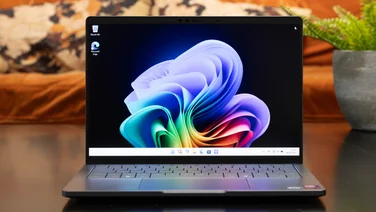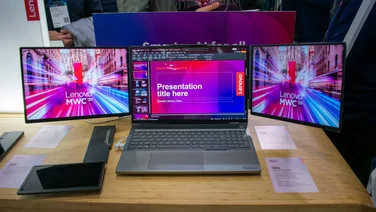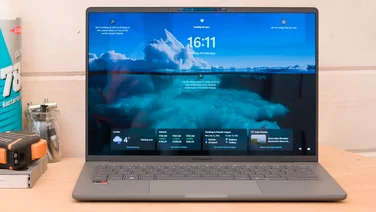To help us provide you with free impartial advice, we may earn a commission if you buy through links on our site. Learn more











- Fantastic battery life
- 4G connectivity
- Superb speakers
- Mediocre keyboard
- Some Windows apps won’t run
The Samsung Galaxy Book S marks an important step for the Korean electronics giant: it’s the first laptop Samsung has launched in Europe for more than five years. Although its handheld devices dominate in the UK and Europe, its laptops have been notable for their absence since the firm pulled out of the laptop market in late 2014.
In fact, the only laptop-like devices it has sold since have been the tablet-based 2-in-1 Samsung Galaxy Book and Galaxy Book 2. With the lightweight, slimline Galaxy Book S, however, Samsung is now well and truly back in the game. I think this is a machine you’re really going to want to consider.
READ NEXT: The best laptops to buy right now
Samsung Galaxy Book S review: Price and competition
The Samsung Galaxy Book S costs £999, which is actually very competitive for such a slimline lightweight laptop with a 4G modem. This is the same list price as the cheapest of Microsoft’s Surface Laptop 3 variants (Core i5, 8GB RAM, 128GB SSD) and the Acer Swift 5 we reviewed at the end of 2019 (Core i5, 8GB RAM, 512GB SSD). You can also pick up a MacBook Air at this price but with a slower Intel Core i3 processor inside.
The closest rival to the Galaxy Book S in terms of specification is the Microsoft Surface Pro X, a 2-in-1 tablet/laptop that runs a Microsoft SQ1 processor (effectively the same as the Snapdragon 8cx) and has 4G built-in. However, that’s nearly £130 more expensive than the Samsung Galaxy Book S once you’ve purchased the optional detachable keyboard and nearly £260 more if you want the keyboard and the Surface Pen stylus.
Here’s a list of those alternatives and where to buy them:
- Microsoft Surface Laptop 3 – £999 – Buy from Microsoft
- Microsoft Surface Pro X – £1,129 (inc keyboard) – Buy from Microsoft
- Apple MacBook Air – £999 – Buy from John Lewis
- Acer Swift 5 (2019) – £999 – Buy from Acer
Samsung Galaxy Book S review: Design
We’ve already established that the Samsung Galaxy Book is amazingly thin and light. It also looks great and comes in two colours: a subtle light bronze colour called “Earthy gold” and a more standard silver, titled “Mercury grey”.
Both versions come with metal coating the outside and a rough-feeling matte plastic surrounding the keyboard; the overall effect is of a premium machine that’s able to keep up with the very best ultraportables in the business.
Flip open the lid and you’ll see that, in thoroughly modern fashion, the 13.3in Full HD touchscreen is surrounded by narrow bezels. There’s a pretty good quality but non-Hello compatible 720p webcam above the screen and dual microphones embedded into the area of plastic just above the keyboard.











The keyboard has a full-size UK layout with flat Scrabble-style keys and a wide touchpad that’s plenty big enough to perform Windows 10’s collection of two-, three- and four-finger multitouch gestures. Plus, there’s a fingerprint scanner in the top right corner of the keyboard, embedded into the power button, which makes logging in a little bit less of a pain.
Alas, I’m less of a fan of how the keyboard feels to type on. Although the layout is largely sensible, the key action is mediocre, offering very little travel or feedback. It reminds me a bit of Apple’s much-maligned butterfly-switch keyboard – a little less clicky, perhaps, but very similar in overall feel.











Physical connectivity is limited, as you might expect of a laptop this slim. You get two USB-C sockets – one on the left edge, the other on the right – both of which can be used to charge the machine or output a video signal to an external monitor. There’s also a 3.5mm headset jack on the left edge, just next to one of the USB-C ports, and a SIM/microSD card tray on the base of the machine.
Wireless connectivity, on the other hand, is excellent with both 2×2 802.11ac Wi-Fi and 4G available courtesy of the 8cx’s integrated Qualcomm X24 modem. Download and upload speeds are rated at up to 2Gbits/sec and 316Mbits/sec respectively and while I got nowhere near these maximums, I was able to achieve download speeds approaching that of a decent broadband connection (31Mbits/sec) with only two bars of signal strength. That’s pretty impressive in my book.











Samsung Galaxy Book review: Display and audio
You’re getting a pretty decent screen here, too. It measures 13.3in across the diagonal, so it’s slightly larger than the Microsoft Surface Pro X’s although the resolution isn’t as high at 1,920 x 1,080. That’s perfectly sharp for a screen that’s going to sit further than a foot away from your eyes most of the time, though.
It isn’t quite as bright as the Pro X’s display – at a peak of 378cd/m2 compared to 452cd/m2 – but can otherwise keep pace; its sRGB coverage sits at 94.5% and contrast ratio at a solid 1,290:1.











There’s no hint of HDR compatibility here, unfortunately, but everything you choose to look at on this display will look bright, crisp and vivid without veering off into over-saturated territory. In short, it’s a very good screen.
I was also impressed, much to my surprise, by the quality of the Galaxy Book S’ speakers. They can’t reproduce any bass to speak of but the audio emanating from this tiny laptop is impressively warm and rich. It sounds especially good with voices, making it the perfect tool for voice and video calls, but it’s also good enough to make listening to a little light classical a perfectly pleasant experience.
READ NEXT: The best tablets to buy right now
Samsung Galaxy Book S review: Performance and battery life
Perhaps the most interesting aspect of the Samsung Galaxy Book S is its performance.
This is somewhat tricky to gauge using our normal selection of benchmarks because our tough in-house media benchmarks won’t run on this machine and neither will the cross-platform OpenGL gaming benchmark, GFXBench.
So, instead I’ve had to rely solely to on the cross-platform Geekbench 4 and 5 tools to see how it stacks up:


A quick glance at the graphs above suggests that there’s quite a discrepancy in CPU-bound performance between the Core i5-based laptops and the Snapdragon laptops both in single- and multi-tasking. And that much is backed up in the way the Galaxy Book S feels to use. Most of the time it’s fine but load up Edge with a lot of tabs and you won’t be zipping about as quickly as you might when using a Surface Laptop 3 or an Acer Swift 5.
And don’t forget that although this laptop will run a wide variety of Windows software – you can even run heavyweight apps such as Photoshop if you like – you can’t currently install and run software only available as 64-bit Intel distributions. Also worth noting is that, unless the developer has taken the time to produce a native ARM or ARM64 version of its app, the Samsung Galaxy Book S will run the 32-bit Windows version emulated, which does have an impact on performance.
This has no effect on disk load and write speed, of course, where the Book S’ 256GB SSD performs well but not amazingly:

All disappointment with the Samsung Galaxy Book S’ performance falls by the wayside, however, when you look at the battery life graph:

This is, quite frankly, an astonishing level of stamina for a modern Windows laptop; The Galaxy Book S beats all of its close rivals, outlasting even the Surface Pro X by more than four hours. In short, you’ll be able to use this machine all day without even worrying about running out of juice even if you’re connecting via Wi-Fi and 4G.
The only laptops that come close that we’ve recently tested are the Google Pixelbook Go and the Asus Chromebook Flip C436F. Although both are lovely laptops, they’re Chromebooks, and can’t run Windows software like the Samsung Galaxy Book S can.
Samsung Galaxy Book S review: Verdict
There are many things to love about the Samsung Galaxy Book S. It’s very slim and light, and it has a great screen and phenomenal battery life. You can connect to the internet via 4G from wherever you are and it has surprisingly good speakers for a laptop this compact as well. Only that rather mediocre keyboard is holding me back from gushing over this laptop more, and I’m fast getting used to the way that feels anyway.











It’s still, however, very early days for laptops based on ARM chips such as the Snapdragon 8cx. Although it works very well the majority of the time there will be moments when you find software you’d like to be able to use that doesn’t run smoothly or at all.
With that in mind, I’d recommend the Windows Surface Laptop 3 13.5in over the Samsung Galaxy Book S for most people, based purely on grounds of performance and compatibility. However, if long battery life and 4G connectivity are imperative there’s nothing that can hold a candle to the Samsung Galaxy Book S.





